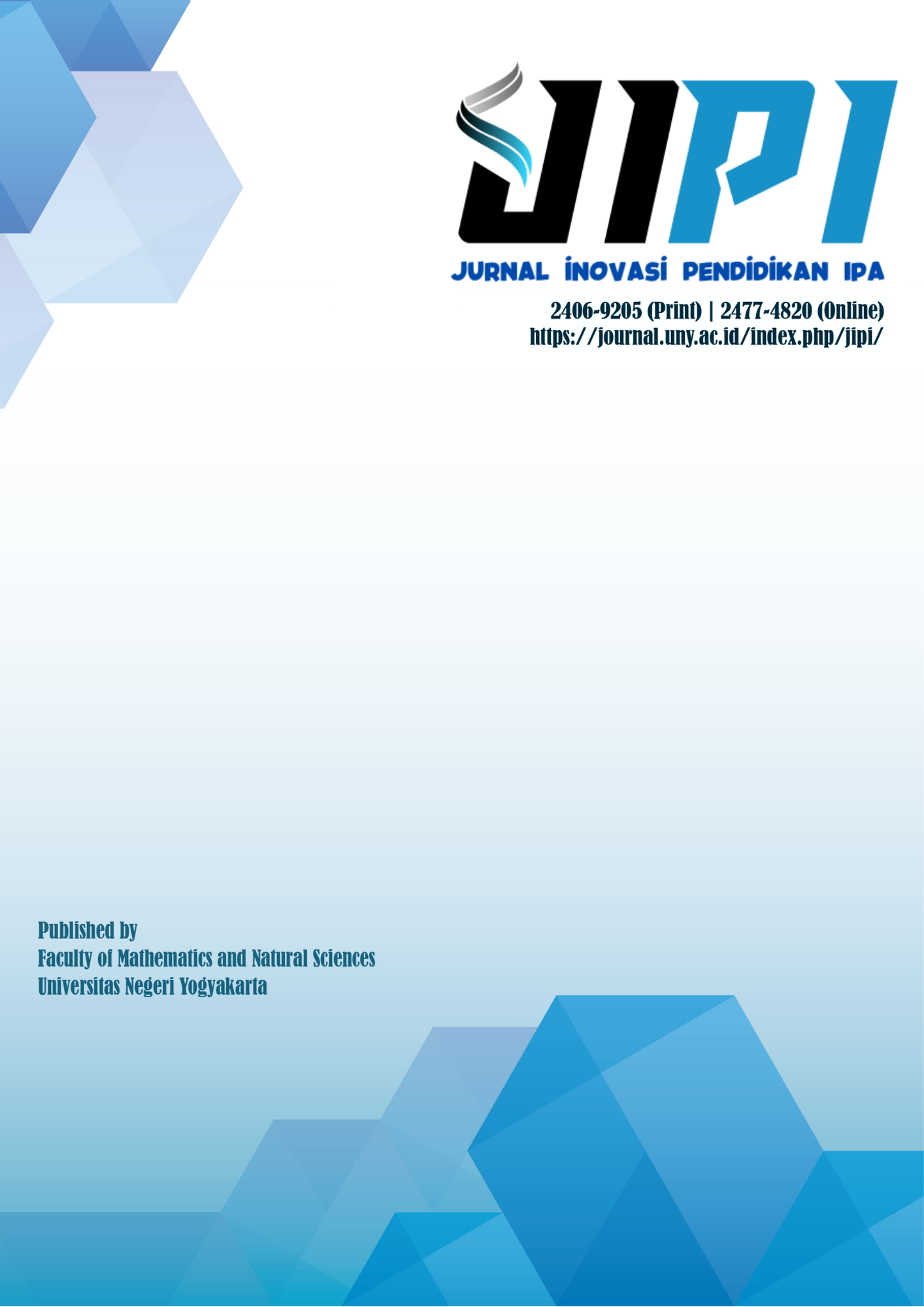Fostering students' critical thinking skill in chemistry through science, technology, society, environment (STSE) collaborative learning
DOI:
https://doi.org/10.21831/jipi.v7i2.37628Keywords:
chemistry education, collaborative learning, STSE learning approach, critical thinking skillAbstract
References
Abubakar, A. B. & Arsyad, M. Y. (2015). Collaborative learning and skills of problem-based learning: a case of Nigerian secondary school's chemistry students. Asian Social Science, 11(27), 53-62. https://dx.doi.org/10.5539/ASS.V11N27P53
Arifin, I. (2019). Kepemimpinan religio-humanistik bidang pendidikan pada era revolusi industry 4.0 dan society 5.0. Monograph. Malang: Universitas Negeri Malang.
Astuti, M., Manurung, B. & Juriani. (2019). The effect of science, environment, technology, and society (SETS) approach assisted by visual media on critical thinking ability and students' scientific attitudes in the material of living creator classification. Indonesian Science Education Research, 1(1) 26-33. https://dx.doi.org/10.24114/iser.v1i1.15497
Chandra, R. (2015). Collaborative learning for educational achievement. International Journal of Research & Method in Education, 5(2),1 -4. https://dx.doi.org/10.9790/7388-052
Cooper, M. M., Cox, C. T., Nammouz, M, & Case, E (2008). An assessment of the effect of collaborative groups on students' problem-solving strategies and abilities. Chemical Education Research, 85(6), 866-872. https://dx.doi.org/10.1021/ed085p866
Duran, M. (2016). The effect of the inquiry-based learning approach on student's critical-thinking skills. Eurasia Jurnal of Mathematics, Science & Technology Education, 12(12), 2887-2908. https://dx.doi.org/doi.org/10.12973/eurasia.2016.02311a
Facione, A. P. (1994). Holistic critical thinking scoring rubric. San Fransisco: California Academia Press.
Gathong, S & Chamrat, S. (2019). Pre-service teachers' teaching practice of science technology society environment (STSE) learning approach integrated nature of science during internship. AIP Conference Proceedings 2081 (030004), 1-8. https://dx.doi.org/10.1063/1.5094002
Ghozali, I. (2011). Aplikasi analisis multivariate dengan program IBM SPSS 19. Semarang: Universitas Diponegoro.
Hairida & Lukman, H. (2017). Improving students's critical thinking skills through SETS vision learning. Unnes Science Education Journal, 6(2), 1571-1576. https://dx.doi.org/10.15294/usej.v6i2.15824
Karim & Normaya. (2015). Kemampuan berpikir kritis siswa dalam pembelajaran matematika dengan menggunakan model JUCAMA di Sekolah Menengah Pertama. Jurnal Pendidikan Matematika 3(1), 92-104. http://dx.doi.org/10.20527/edumat.v3i1.634
Le, H., Janssen, J. & Wubbels, J. (2017). Collaborative learning practice: teacher and studemts perceived obstacles to effective student collaboration. Cambridge Journal of Education, 48(1), 1-20. http://dx.doi.org/10.1080/0305764X.2016.1259389
National Science Teacher Association. (2003). Standards for science teacher preparation. Arlington.
Ridwan, A., Rahmawati, Y. & Hadinugrahaningsih, T. (2017). STEAM integration in chemistry learning for developing 21st century skills. MIER Journal of Studies, Trends & Practice, 7(2), 184-194. http://dx.doi.org/10.52634/MIER/2017/V7/I2/1420
Wanner, T. & Palmer, E. (2018) Formative self-and peer assessment for improved students learning: the crucial factors of design, teacher participation and feedback. Assessment 7 Evaluation in Higher Education, 43(7), 1032-1047. https://doi.org/10.1080/02602938.2018.1427698
Schoor, C., Narciss, S. & Kondle, H. (2015). Regulation during cooperative and collaborative learning: a theory-based review of terms and concepts. Educational Psychologist, 50(2), 97-119. https://doi.org/10.1080/00461520.2015.1038540
Kaendler, C., Wiedmann, M., Rummel, N. & Spada, H. (2015). Teacher competencies for the implementation of collaborative learning in classroom: a framework and research review. Educational Psychology Review, 27(3), 505-536. http://dx.doi.org/10.1007/s10648-014-9288-9
OECD. (2018). PISA 2018: Insights and Interpretations. Organisation for Economic Co-operation and Development Publications.
Poedjiadi, A. (2005). Sains Teknologi Masyarakat (STM). Bandung: Remaja Rosdakarya.
Reid, N. (2008). A scientific approach to teaching chemistry. Chemistry Education Research and Practice, 9(1), 51-59. http://dx.doi.org/10.1039/b801297k
Richardson, J. (2011). Eta squared and partial eta squared as measures of effect size in educational research. Elvesier: Educational Research Review, 6(2011), 135-147. https://doi.org/10.1016/j.edurev.2010.12.001
Sa'Adah, M., Suryaningsih, S., & Buchori, M. (2020). Pemanfaatan multimedia interaktif pada materi hidrokarbon untuk menumbuhkan keterampilan berpikir kritis siswa. Jurnal Inovasi Pendidikan IPA, 6(2), 184-194. http://doi.org/10.21831/jipi.v6i2.29680
Syahmel & Jumadi. (2019). Discovery learning using multiple representation model for enhancing scientific processing and critical thinking skills of students. Jurnal Inovasi Pendidikan IPA, 5(2) 180-194. http://doi.org/10.21831/jipi.v5i2.26704
Syarifudin, S. (2017). The effect of using scientific approach through concept understanding and critical thinking in science. Jurnal Prima Edukasia, 6(1), 21031. http://doi.org/10.21831/jpe.v6i1.15312
Utami, B., Saputro, S., Ashadi, Masyukri, M. & Widoretno. (2016). Critical thinking skill profile of high school students in learning chemistry. International Journal of Science and Applied Science Conference Series, 1(2), 124-130. https://doi.org/10.20961/ijsascs.v1i2.5134
Yazichi, H. J. (2006). A study of collaborative learning style and team learning performance. Emerald Education Training, 47(3), 216-229. https://doi.org/10.1108/00400910510592257
Yoruk, N., Morgil, I. & Secken, N. (2009). The effects of science, technology, society, and environment (STSE) education on students' career planning. US-China Education Review, 6(8), 68-74.
Yoruk N, Morgil, I, & Secken, N. (2010). The effects of science, technology, society, environment (STSE) inteactions on teaching chemistry. Natural Science Journal, 2(12), 1417-1424. https://doi.org/10.4236/ns.2010.212173
Yusuf, S. D. (2014). Effects of collaborative learning on chemistry students' academic achievement and anxiety level in balancing chemical equations in secondary school in Katsina Metropolis Nigeria. Journal of Education and Vocational Research, 5(2), 43-48. https://doi.org/10.22610/jevr.v5i2.151
Downloads
Published
How to Cite
Issue
Section
Citation Check
License
The authors submitting a manuscript to this journal agree that, if accepted for publication, copyright publishing of the submission shall be assigned to Jurnal Inovasi Pendidikan IPA (JIPI). However, even though the journal asks for a copyright transfer, the authors retain (or are granted back) significant scholarly rights.
Jurnal Inovasi Pendidikan IPA by http://journal.uny.ac.id/index.php/jipi/index is licensed under a Creative Commons Attribution-ShareAlike 4.0 International License.










